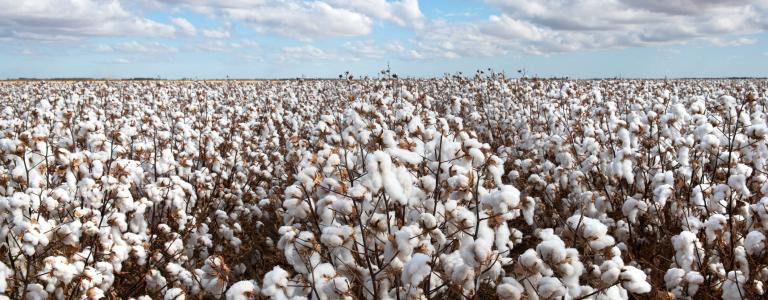Sustainable Cotton or Recycled Polyester? The conscious shopper’s dilemma
Some brands claim to be sustainable but not all of their products meet the same criteria and transparency gaps abound. How can the average consumer make the right decisions? Our experts offer some guidance.
Today’s USD 3 trillion fashion industry offers eco-minded consumers a plethora of “sustainable” and ethical clothing options, from organic cotton t-shirts to leggings made from recycled plastic bottles.
However, assessing the environmental and social impacts of the various materials used in such apparel can be tough in a marketplace where brands will deploy any number of tactics to sell you a hemp scarf that warms your shoulders while easing your conscience.
In a recent report, IISD provides a market performance overview of the most popular fibre used in textiles and a pillar of the fashion industry—cotton. One thing is clear: consumers must consider many factors when shopping for eco-friendly garments. Sustainability performance can vary between products of the same brand, and transparency gaps abound in the garment industry, which can make informed decisions challenging.
Here are some guidelines to help make the process easier:
Look for Brands With Public and Ambitious Sustainability Commitments
Our cotton report, launched in July 2020, tracks how large fashion brands are driving the growth of cotton produced under voluntary sustainability standards (VSSs), such as the Better Cotton Initiative (BCI), Organic (including Global Organic Textile Standard [GOTS] and Organic Content Standard [OCS]), and Cotton made in Africa (CmiA). VSS-compliant production of cotton made up at least 14.1% of the global total in 2016 and is expected to rise in the coming years.
VSSs push cotton producers to limit their negative environmental and social impacts, for instance, by reducing water and pesticide use and improving wages and working conditions.

Not All Voluntary Standards Are Created Equal
Our research shows the most prevalent VSS schemes in the cotton sector (in order of production volume) are the BCI, CmiA, Organic, and Fairtrade International. While all of these standards can push producers to mitigate negative environmental and social impacts related to cotton production, their compliance criteria vary.
Assessing the environmental and social impacts of various materials used in a product can be tough in a marketplace where brands will deploy any number of tactics to sell you a hemp scarf that warms your shoulders while easing your conscience.
For instance, schemes such as Organics, GOTS and OCS ensure that certified cotton is labelled and identified as such at all stages of the supply chain (identity preserved), this means that organic fibres are not mixed with conventional ones, while others, such as BCI, provide physical traceability of certified fibres at the farm and gin levels, and allow the mixing of certified and conventional fibres after the ginning process. Also, some standards (such as BCI), allow the use of genetically modified cotton, while Organic, Fairtrade, and CmiA do not.
Natural vs. Synthetic? It’s complicated
The negative environmental impacts come early in the life cycle of natural, plant-based fibres such as cotton, linen, and hemp. For instance, farming can often involve intense water and pesticide use. However, after production, these natural fabrics perform well on sustainability because they are often recyclable and are fully biodegradable.
Concerning cotton, VSSs are helping to mitigate the negative impacts of producing the crop by prohibiting the use of pesticides, reducing water usage, improving soil fertility, and creating positive impacts on health and working conditions in farming communities. One study by the Textile Exchange found that farming organic cotton reduces the crop’s global warming potential by 46% compared to conventional cotton.
VSSs are helping to mitigate the negative impacts of producing the crop by prohibiting the use of pesticides, reducing water usage, improving soil fertility, and creating positive impacts on health and working conditions in farming communities.
It’s important to note that there is no middle ground here: blending natural and synthetic fibres will sacrifice a garment’s recyclability and biodegradability.
Read Labels Closely
Brands are eager to put the sheen of sustainability on their products, but be wary of vague claims, such as “Made with recycled material” (or other eco-friendly fabric), which doesn’t mention how much of the garment is comprised of the sustainable material. Look for clear, quantified sustainability claims, often expressed as a percentage.
Stay Informed
More-informed consumers can make more-informed demands in the marketplace. Platforms such as CottonUP and Fashion for Good have surfaced to promote more sustainable decision making in the marketplace. In our research on cotton, we’ve seen how consumers can play an important role, as environmental and social concerns have pushed some of the big global brands to purchase more VSS-compliant cotton.
Moving something as large as the global fashion industry toward sustainability will take a massive effort, but the payoff could be huge; if the sector continues on its current path, doing “business as usual,” it may comprise up to 25% of the world’s carbon budget by 2050, making it the second most polluting industry after oil and gas.
You might also be interested in
The Responsible Agricultural Investment Tool for Agribusiness and Case Studies
This report summarizes a collaboration to support agribusinesses in complying with principles of responsible investment in agriculture and food systems.
New tool empowers businesses to make food systems sustainable
The Responsible Agricultural Investment (RAI) Tool for Agribusiness helps business leaders put principles into practice in the drive to improve sustainability in agrifood systems.
The Responsible Agricultural Investment Tool for Agribusiness
This tool aims to support agribusinesses in aligning their practices, procedures, and operations with principles of responsible investment in agriculture and food systems.
Rethinking Investment Treaties
International investment treaties and their investor–state dispute settlement (ISDS) system are facing growing scrutiny. But what would an alternative system—one fit for the challenges of the 21st century—look like?
